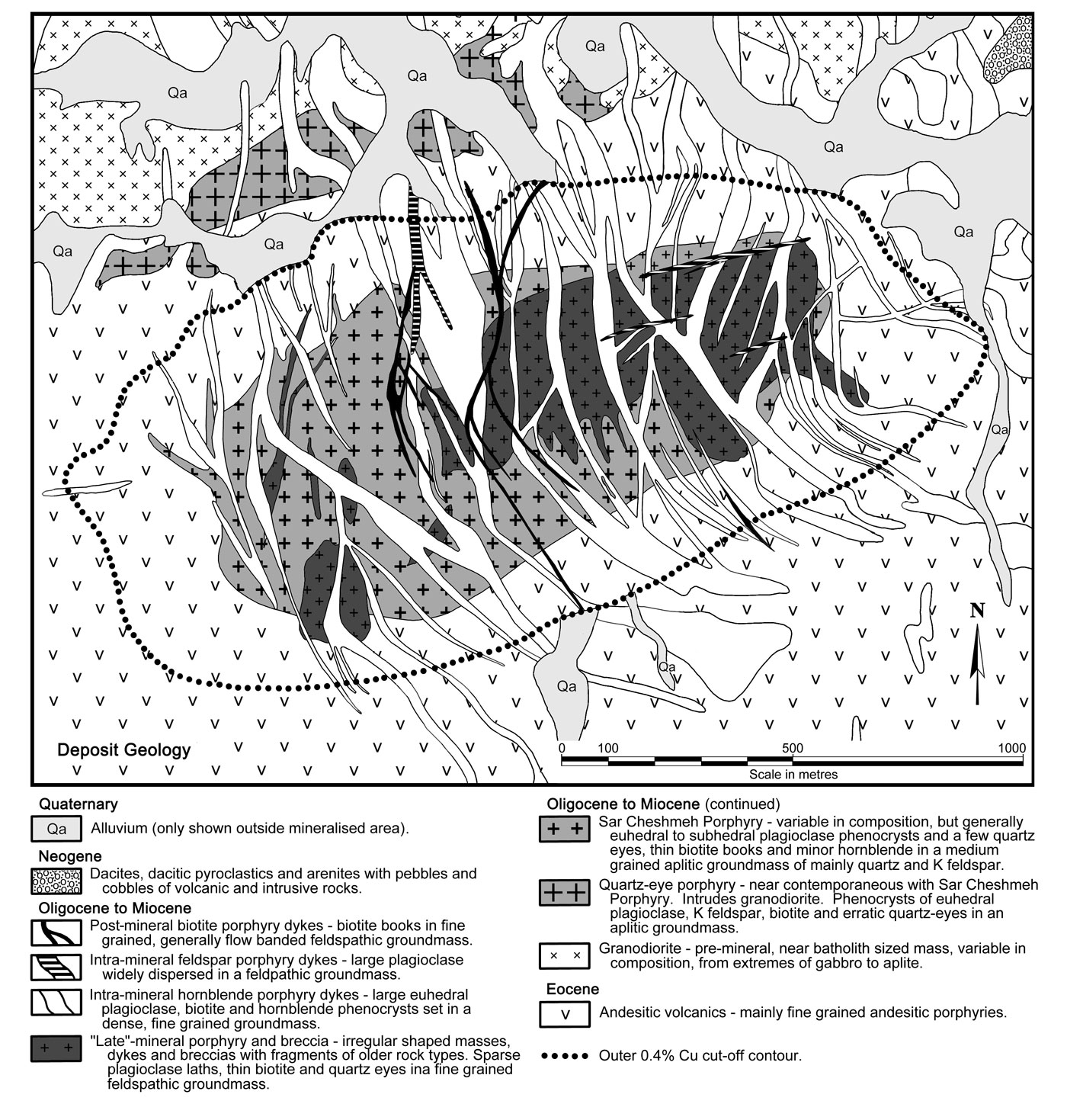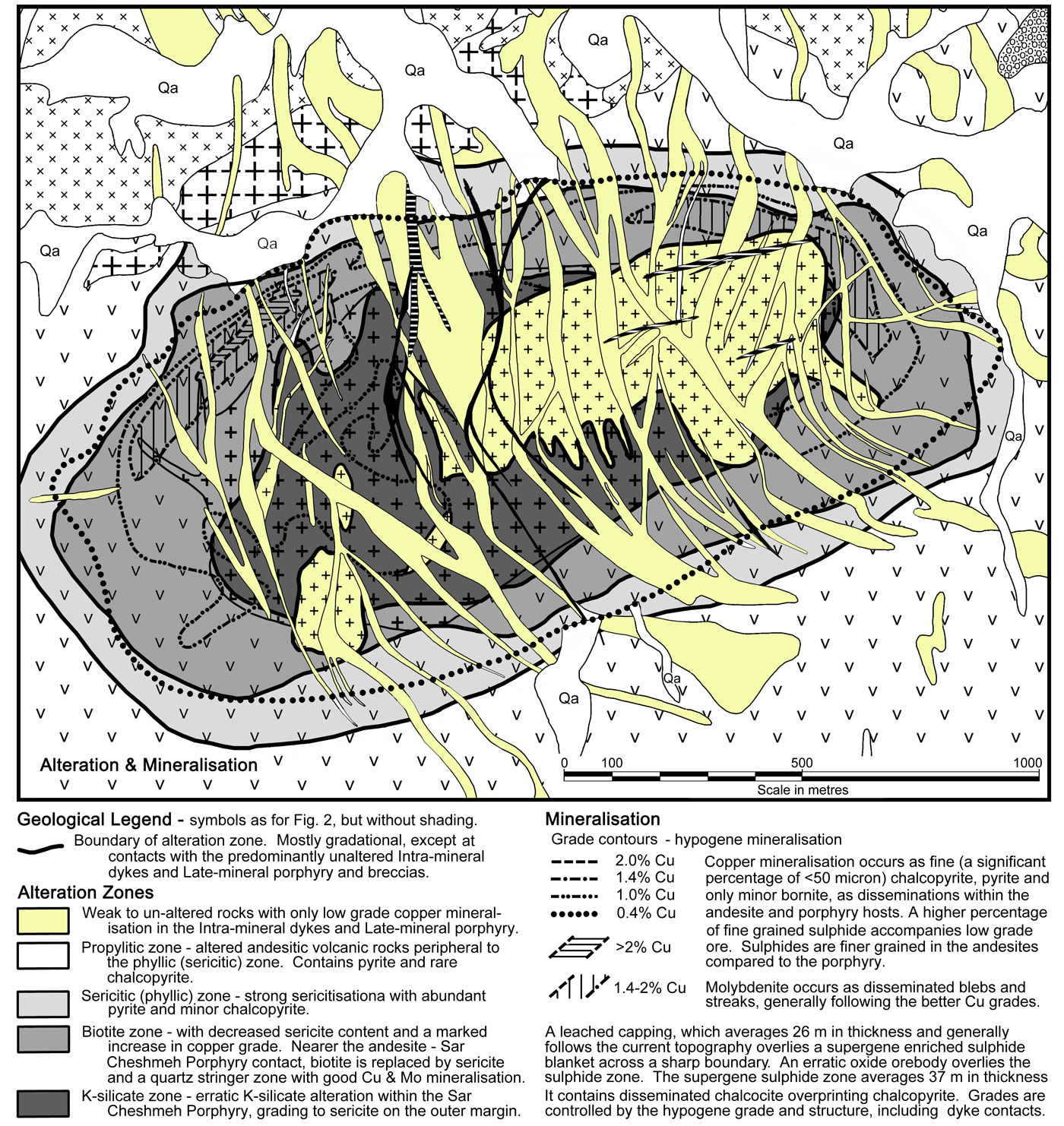|
Sar Cheshmeh, Sarcheshmeh |
|
|
Iran |
| Main commodities:
Cu Au Mo
|
|
 |
|
 |
 |
Super Porphyry Cu and Au


|
IOCG Deposits - 70 papers

|
All papers now Open Access.
Available as Full Text for direct download or on request. |
|
 |
Sarcheshmeh or Sar Cheshmeh porphyry copper deposit is located 60 km south of the city of Rafsanjan in southwest Kerman Province, at an altitude of approximately 2500 m above sea level (#Location: 29° 56' 46"N. 55° 51' 56"E).
It is the largest porphyry copper deposit known in Iran, containing a geological resource of 1200 Mt of sulphide ore at an average grade of 1.2% Cu, 0.03% Mo, 0.27g/t Au, and 3.9 g/t Ag (Ellis, 1991). The deposit It is elongate in shape, with dimensions of around 2000 m in length by 1000 m in width and trends northeast-southwest. There are two low grade porphyry copper deposits to the south and north of the Sar-Cheshmeh mine which the National Iranian Copper Company NICICO plans to develop in the future by extending the current open pit.
The Sarcheshmeh porphyry Cu (Mo) deposit was developed within a continental margin type calc-alkaline volcano-plutonic series of Tertiary age, emplaced on the margin of the Central Median Mass (CMM) of Iran. The CMM was surrounded by an oceanic basin, the remnants of which are recognised as ophiolites and ophiolitic mélanges in Tabriz, Takab, Naiin-Baft, Sabzevar and Gonabad-Birjand areas. Subduction and consumption of this oceanic crust beneath the CMM caused the development of continental margin-type Eocene-Miocene volcano-plutonic complexes hosting Cu-(Mo, Au), and Pb-Zn deposits. For details of the regional setting see the Iranian Porphyry Copper Province record.
Mineralisation at Sar Cheshmeh is related to a granodioritic stock intruded into Eocene andesitic host rocks.
Waterman and Hamilton (1975) and Shahabpour and Kramers (1987) have reported six magmatic units in the Sar-Cheshmeh deposit, namely:
i). Major granodiorite stock SCP
ii). Late feldspar porphyry LFP
iii). Early hornblende porphyry EHP
iv). Late hornblende porphyry LHP
v). Feldspar porphyry dykes FP
vi). Biotite porphyry dykes BP
Rapid erosion has exposed the magmatic sequence both at the deposit and in the surrounding area, where the Miocene Sar-Cheshmeh granodioritic porphyry has intruded Eocene andesites (Waterman and Hamilton, 1975; Ellis, 1991 Shahabpour and Kramers, 1987). The first three units (SCP, LFP and EHP) are mineralised with copper although the major ores are hosted in biotitic andesite and the granodiorite stock (SCP), especially on the contact zone of the SCP. The grade of Cu decreases with depth in the hypogene zone, while the Mo content increases. (Waterman and Hamilton, 1975).
Intrusion of the Sar-Cheshmeh porphyry stock into the Eocene andesitic wall rock created four alteration zones associated with the deposit. These consist of a core of strong biotite alteration, grading out to weak biotite, followed by a strong phyllic zone and an outer peripheral halo of pyrophyllite. About 50 percent of the ore reserve is in the andesitic host rocks which have been hydrothermally altered to the biotitic (brown), phyllic (light green) and propylitic (dark green) series. Intense biotite alteration is visible close to the contact zone of granodiorite and andesite and decreases with distance from the periphery.
The intense biotitisation and overprinting, abundant phyllic zone are the most important features in the alteration pattern at Sar Cheshmeh. Different zones of mineralisation include hypogene chalcopyrite, molybdenite and magnetite, with minor bornite, which have been replaced in the supergene blanket by chalcocite. These sulphides occur both as disseminations and in veinlets.
 The deposit scale geological setting and lithologies of the Sar Cheshmeh porphyry copper deposit, southeastern Iran
The deposit scale geological setting and lithologies of the Sar Cheshmeh porphyry copper deposit, southeastern Iran

The distribution of alteration and mineralisation on the 2400 m elevation level at the Sar Cheshmeh porphyry
copper deposit, southeastern Iran. After Waterman and Hamilton (1975), Ghorashi-Zadeh (1979).
The major ore minerals are chalcopyrite, and rarely bornite. The chalcopyrite minerals can be divided into magmatic, potassic and phyllic types on the basis of' metallic impurities such as Co, Ni, Zn and Au. Saffari (1998) has studied gold, and silver distribution in the Sarcheshmeh deposit and concluded that chalcopyrite is the major gold carrier mineral, regardless of its generation.
The first geochronological study of the deposit was undertaken by Shahabpour and Kramers (1987). Pb/Pb isotope ratios yielded ages of 18.580 ± 0.005 and 15.581 ± 0.004 Ma respectively for the Sar-Cheshmeh porphyry.
The total "proved" plus "probable" sulphide ore reserve from the surface to the 2350 bench elevation, at a 0.40% total Cu cutoff is as follows, (Waterman and Hamilton 1975):
Supergene Ore: 92.348 Mt @ 1.996% Cu total
Hypogene Ore: 335.175 Mt @ 0.895% Cu total
Total Ore: 427.532 Mt @ 1.133% Cu total.
Aghazadeh et al. (2015) quote a resource at Sar Cheshmeh of 1200 Mt @ 0.6% Cu, 0.02% Mo.
For detail consult this paper or other reference(s) listed below.
The most recent source geological information used to prepare this decription was dated: 2004.
This description is a summary from published sources, the chief of which are listed below.
© Copyright Porter GeoConsultancy Pty Ltd. Unauthorised copying, reproduction, storage or dissemination prohibited.
Sar Cheshmeh
|
|
|
|
|
Aghazadeh, M., Hou, Z., Badrzadeh, Z. and Zhou, L., 2015 - Temporal-spatial distribution and tectonic setting of porphyry copper deposits in Iran: Constraints from zircon U-Pb and molybdenite Re-Os geochronology: in Ore Geology Reviews v.70, pp. 385-406.
|
Asadi, S., 2018 - Triggers for the generation of post-collisional porphyry Cu systems in the Kerman magmatic copper belt, Iran: New constraints from elemental and isotopic (Sr-Nd-Hf-O) data: in Gondwana Research v.64, pp. 97-121.
|
Atapour H and Aftab A, 2007 - The geochemistry of gossans associated with Sarcheshmeh porphyry copper deposit, Rafsanjan, Kerman, Iran: Implications for exploration and the environment: in J. of Geochemical Exploration v93 pp 47-65
|
Boomeri, M., Nakashima, K. and Lentz, D.R., 2010 - The Sarcheshmeh porphyry copper deposit, Kerman, Iran: A mineralogical analysis of the igneous rocks and alteration zones including halogen element systematics related to Cu mineralization processes: in Ore Geology Reviews v.38, pp. 367-381.
|
Hezarkhani A, 2006 - Hydrothermal evolution of the Sar-Cheshmeh porphyry Cu-Mo deposit, Iran: Evidence from fluid inclusions : in J. of Asian Earth Sciences v28 pp 409-422
|
McInnes B I A, Evans N J, Fu F Q, Garwin S, Belousova E, Griffin W L, Bertens A, Sukarna D, Permanadewi S, Andrew R L and Deckart K, 2005 - Thermal History Analysis of Selected Chilean, Indonesian and Iranian Porphyry Cu-Mo-Au Deposits: in Porter T M (Ed), 2005 Super Porphyry Copper & Gold Deposits - A Global Perspective, PGC Publishing, Adelaide, v.1 pp. 27-42
|
Richards, J.P. and Sholeh, A., 2016 - The Tethyan Tectonic History and Cu-Au Metallogeny of Iran: in Richards, J.P. (Ed.), 2016 Tectonics and Metallogeny of the Tethyan Orogenic Belt, SEG Special Publication 19, Ch. 7, pp. 193-212.
|
Samani B, 1998 - Distribution, Setting and Metallogenesis of Copper Deposits in Iran: in Porter T M (Ed.), 1998 Porphyry and Hydrothermal Copper and Gold Deposits - A Global Perspective PGC Publishing, Adelaide pp. 151-174
|
Shafiei, B., Haschke, M. and Shahabpour, J., 2009 - Recycling of orogenic arc crust triggers porphyry Cu mineralization in Kerman Cenozoic arc rocks, southeastern Iran: in Mineralium Deposita v.44, pp. 265-283.
|
Waterman G C and Hamilton R L, 1975 - The Sar Cheshmeh porphyry copper deposit : in Econ. Geol. v.70 pp. 568-576
|
Zarasvandi A, Liaghat S and Marcos Zentilli M, 2005 - Porphyry Copper Deposits of the Urumieh-Dokhtar Magmatic Arc, Iran: in Porter, T.M. (Ed), 2005 Super Porphyry Copper & Gold Deposits - A Global Perspective, PGC Publishing, Adelaide, v.2 pp. 441-452
|
|
Porter GeoConsultancy Pty Ltd (PorterGeo) provides access to this database at no charge. It is largely based on scientific papers and reports in the public domain, and was current when the sources consulted were published. While PorterGeo endeavour to ensure the information was accurate at the time of compilation and subsequent updating, PorterGeo, its employees and servants: i). do not warrant, or make any representation regarding the use, or results of the use of the information contained herein as to its correctness, accuracy, currency, or otherwise; and ii). expressly disclaim all liability or responsibility to any person using the information or conclusions contained herein.
|
Top | Search Again | PGC Home | Terms & Conditions
|
|